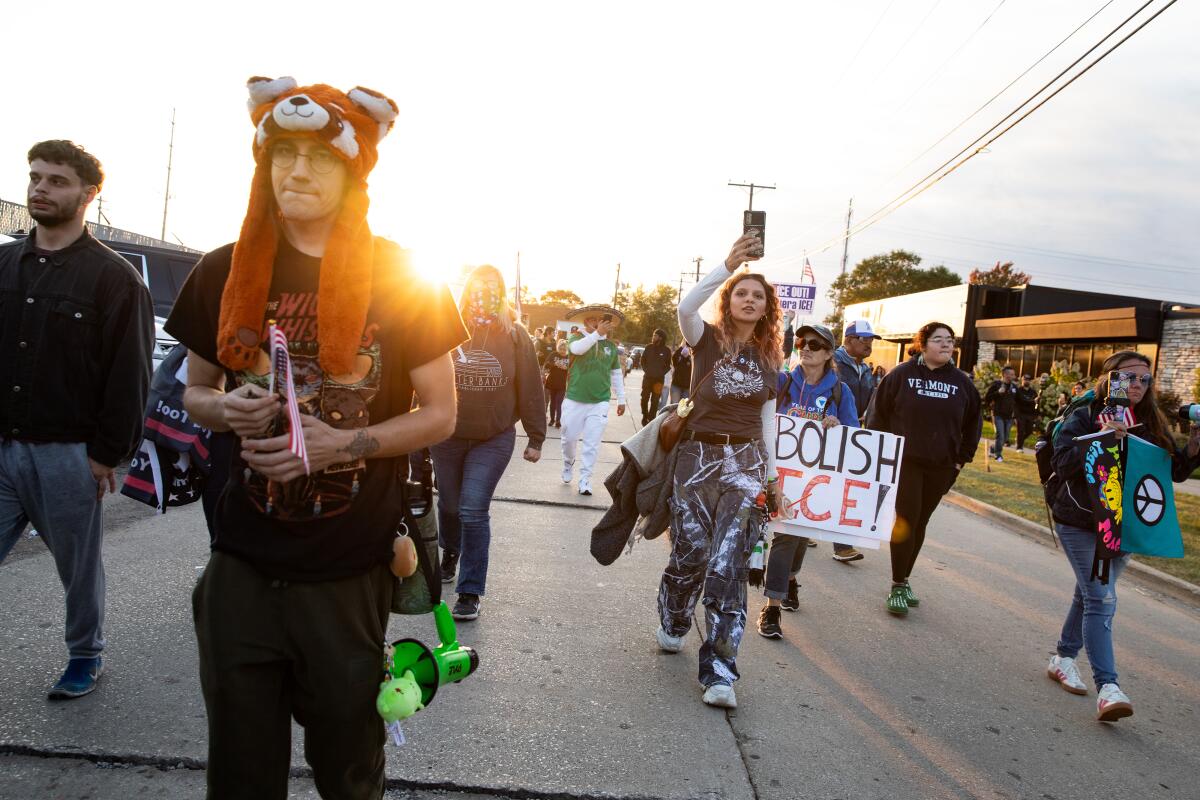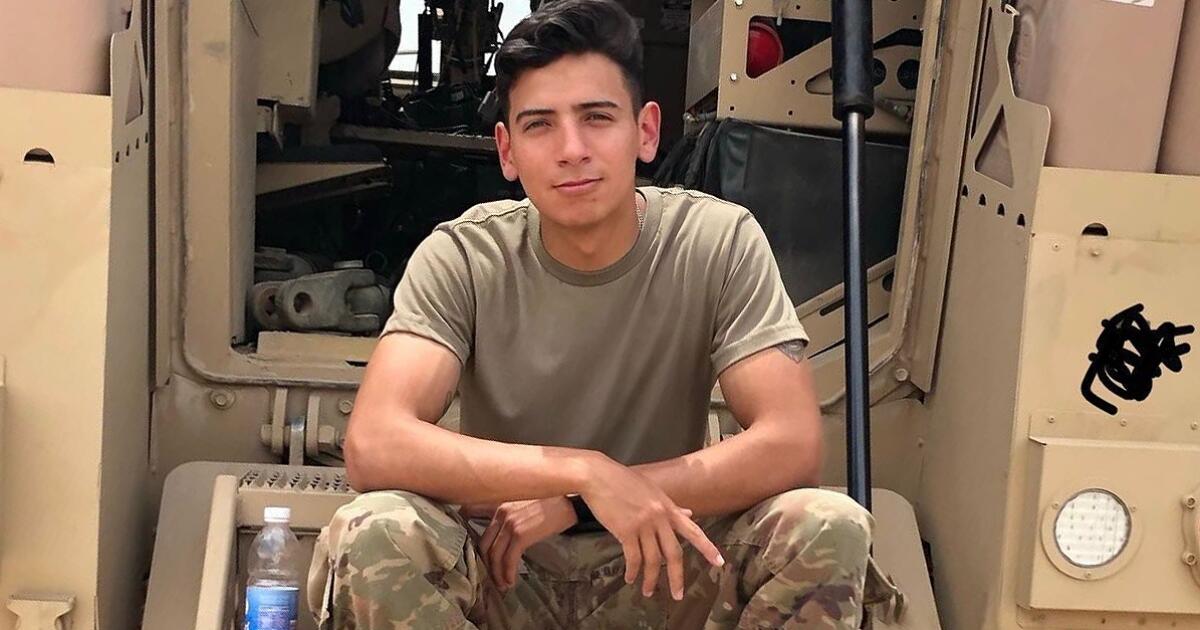Echoing the raids in L.A., parts of Chicago are untouched by ICE, others under siege
CHICAGO — Since the Trump administration announced its intention to accelerate and forcefully detain and deport thousands of immigrants here, the Chicago area is a split screen between everyday life and a city under siege.
As many people shop, go to work, walk their dogs and stroll with their friends through parks, others are being chased down, tear-gassed, detained and assaulted by federal agents carrying out immigration sweeps.
The situation is similar to what occurred in Los Angeles in summer, as ICE swept through Southern California, grabbing people off the street and raiding car washes and Home Depots in predominantly Latino areas, while leaving large swaths of the region untouched.
Take Sunday, the day of the Chicago Marathon.
Some 50,000 runners hailing from more than 100 countries and 50 states, gathered downtown to dash, jog and slog over 26.3 miles of Lake Michigan shoreline and city streets.
The sun was bright, the temperatures hovered in the upper-60s, and leaves of maple, oak, aspen and ginkgo trees colored the city with splashes of yellow, orange and red.
Demonstrators march outside the Immigration and Customs Enforcement detention facility in Broadview, Ill., on Oct. 10.
(Kayana Szymczak/For The Times)
It was one of those rare, glorious Midwestern fall days when everyone comes outside to soak in the sunlight, knowing the gloom and cold of winter is about to take hold.
At 12:30, Ludwig Marchel and Karen Vanherck of Belgium strolled west along East Monroe Street, through Millennium Park. They smiled and proudly wore medals around their necks commemorating their marathon achievement. They said they were not concerned about coming to Chicago, despite news stories depicting violent protests and raids, and the Trump administration’s description of the city as “war torn,” a “hellhole,” a “killing field” and “the most dangerous city in the world.”
“Honestly. I was mostly worried that the government shutdown was somehow going to affect my flight,” said Marchel. He said he hadn’t seen anything during his few days in town that would suggest the city was unsafe.
Another man, who declined to give his name, said he had come from Mexico City to complete the race. He said he wasn’t concerned, either.
“I have my passport, I have a visa, and I have money,” he said. “Why should I be concerned?”
At that same moment, 10 miles northwest, a community was being tear-gassed.
Dozens of residents in the quiet, leafy neighborhood of Albany Park had gathered in the street to shout “traitor” and “Nazi” as federal immigration agents grabbed a man and attempted to detain others.
According to witness accounts, agents in at least three vehicles got out and started shoving people to the ground before throwing tear gas canisters into the street. Videos of the event show masked agents tackling a person in a red shirt, throwing a person in a skeleton costume to the ground, and violently hurling a bicycle out of the street as several plumes of smoke billow into the air. A woman can be heard screaming while neighbors yell at the agents.
Last week, a federal judge issued a temporary restraining order requiring agents to issue two warnings before using riot control weapons such as tear gas, chemical sprays, plastic bullets and flash grenades.
Witnesses told the Chicago Sun-Times that no warnings had been given.
Deirdre Anglin, community member from Chicago, takes part in a demonstration near an Immigration and Customs Enforcement detention facility in Broadview, Ill., on Oct. 10.
(Kayana Szymczak/For The Times)
Since Trump’s “Operation Midway Blitz” was initiated more than six weeks ago, roughly 1,000 people have been arrested or detained.
At the ICE detention facility, in Broadview — a suburb 12 miles west of downtown — there have been daily protests. While most have been peaceful, some have devolved into physical clashes between federal agents or police and protesters.
In September, federal agents shot pepper balls and tear gas at protesters peacefully gathering outside the facility. On Saturday, local law enforcement forced protesters away from the site with riot sticks and threats of tear gas. Several protesters were knocked to the ground and forcefully handcuffed. By the end of the evening, 15 people had been arrested.
Early Sunday afternoon, roughly two dozen protesters returned to the site. They played music, danced, socialized and heckled ICE vehicles as they entered and exited the fenced-off facility.
In a largely Latino Chicago neighborhood called Little Village, things appeared peaceful Sunday afternoon.
Known affectionately by its residents as the “Midwestern capital of Mexico,” the district of 85,000 is predominantly Latino. Michael Rodriguez, a Chicago city councilman and the neighborhood’s alderman, said 85% of the population is of Mexican descent.
On Sunday afternoon, traditional Mexican music was being broadcast to the street via loudspeakers from the OK Corral VIP, a western wear store.
Demonstrators protest near an Immigration and Customs Enforcement detention facility in Broadview, Ill., on Oct. 10.
(Kayana Szymczak/For The Times)
Along East 26th Street, where shops and buildings are painted with brightly colored murals depicting Mexican folklore, history and wildlife — such as a golden eagle and jaguar — a family sat at a table eating lunch, while two young women, in their early 20s, laughed and chattered as they strolled west toward Kedzie Avenue.
Rodriguez said that despite appearances, “people are afraid.”
He said he spoke with a teacher who complained that several of her elementary-school aged students have stopped coming to class. Their parents are too afraid to walk them or drive them to school, hearing stories of other parents who have been arrested or detained by ICE agents at other campuses in the city — in front of their terrified children.
Rodriguez’s wife, whom he described as a dark-skinned Latina with degrees from DePaul and Northwestern universities, won’t leave the house without her passport.
At a barber shop called Peluqueria 5 Star Fades Estrellas on 26th, a coiffeur named Juan Garcia sat in a chair near the store entrance. He had a towel draped over the back of his neck. He said his English was limited, but he knew enough to tell a visitor that business was bad.
“People aren’t coming in,” he said. “They are afraid.”
Victor Sanchez, the owner of a taco truck parked on Kedzie Road, about a half-mile south of town, said his clientele — mostly construction workers and landscapers — have largely disappeared.
“Business is down 60%,” he said to a customer. “I don’t know if they have been taken, or if they are too afraid to come out. All I know is they aren’t coming here anymore.”
Rodriguez said that ICE agents have arrested people who live in his neighborhood, but those arrests took place outside the borders of his district.
“I think they know this is a well-organized and aware neighborhood,” he said. “I think they’ve cased it and decided to grab people on the outskirts.”

